Sticky drops on orchid leaves: what to do?
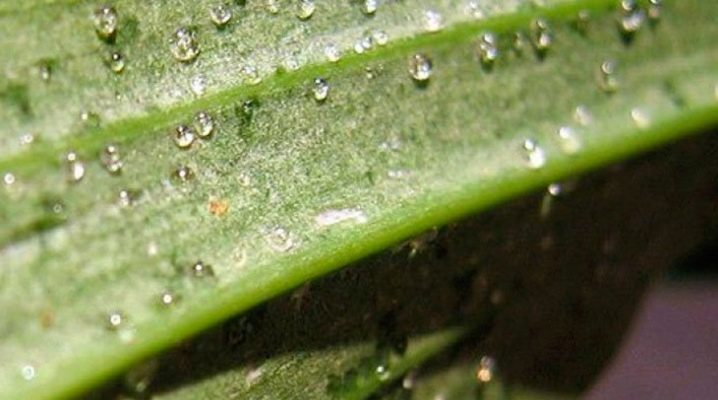
Many housewives love to grow orchids in their homes. But sometimes you can see a lot of sticky drops on these flowers. Today we will talk about why they appear and how to properly treat indoor plants at the same time.
What it is?
Sticky liquid spots usually cover the blades (top and bottom), young shoots, stems and branches of orchids. They are called extra-floral nectarine. They should not be confused with the natural formation of nectar, which cannot harm the flowers.
Reasons for the appearance
There are various reasons on which sticky drops are formed on orchids.
- pest activity;
- improper care;
- disease.
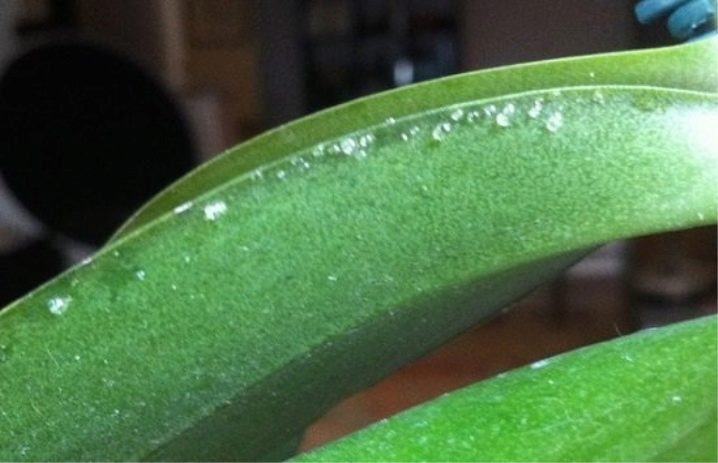
Pest activity
Often, sticky drops can be seen on orchids due to the appearance of ticks and aphids on them. Most often, in this case, you can find on plants and small dots on the outside and back of the leaves, on the trunk, on the flower shoot (these are small insects that have got into the liquid). In this case, the largest amount of plaque appears in the leaf area.
Improper care
A sweet bloom can appear on flowers due to the use of too much fertilizer. If you adjust the feeding in a timely manner, the drops can gradually disappear on their own.
With an excessive amount of fertilizer, the flower should be transplanted immediately, regardless of whether it is blooming at the moment or not. If this is not done in a timely manner, the orchid may die.
It is especially necessary to handle fertilizers containing phosphorus, nitrogen and potassium. After all, they, together with mineral fertilizers, can significantly increase the metabolism of a plant, which will lead to the formation of a layer of mucus on it.
Over-watering orchids can also be harmful. Therefore, you need to carefully monitor the amount of water for such flowers. Sometimes sticky spots can appear due to the natural process of flower nectar formation. In this case, the liquid will not do any harm to the plants.
To determine the level of moisture in the earth, you need to inspect the soil. If it begins to clump or lose its aeration properties, then the plant must be transplanted immediately. The same is done if white mold forms or if there is an unpleasant odor.
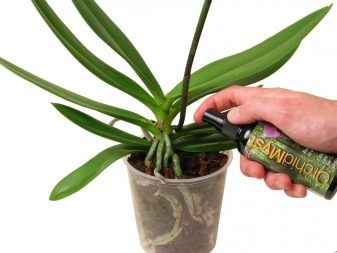
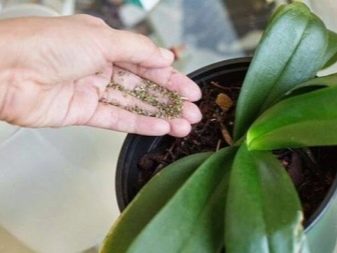
It is also necessary to monitor the temperature, lighting in the room where the orchids are located. They require good lighting, but they should not be placed in direct sunlight. Often a hygrometer is placed next to the plant. This device is designed to control temperature changes in the room.
Diseases
Orchids can often get sick with powdery mildew, which is a common fungal disease. It occurs due to small spores that are easily transported through the air.
With such a disease, in addition to the abundant sticky liquid, large white dots can also form. Together with them, a gray bloom may appear on the leaf blades.
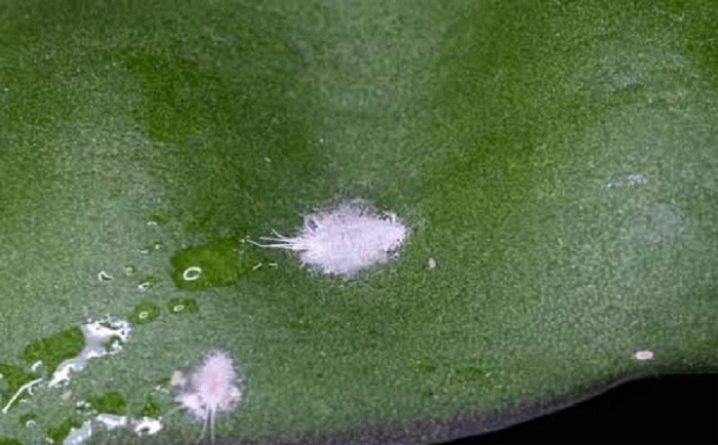
Treatment methods
Nowadays, there are many ways to cure orchids and get rid of their sticky plaque secretions.
- It is recommended to pay attention to watering first... In the winter season, it should be significantly reduced. Indeed, due to the increased level of humidity, the infection will only develop.
- If the plants are covered with small insects, they must be removed.This can be done manually, after which it is recommended to water the flowers with warm water. If an orchid is damaged by a worm, it is also necessary to treat it with a solution of a special preparation containing oil.
- The sweet nectar that appears on the leaves and on the trunk is a waste product of the mealybug. At the same time, on the plates it will be possible to see the harmful insects themselves that have got into the liquid.
- Plants are often affected by the scabbard. This insect can be easily identified by its almost transparent semicircular shell. These parasites secrete a waxy substance that accumulates around them and forms a protective film over time.
- If the flowers are affected by a tick, then you should first remove all damaged parts of the infected plant. After that, it must be transplanted, and the pot in which it was located must be thoroughly rinsed with clean water.
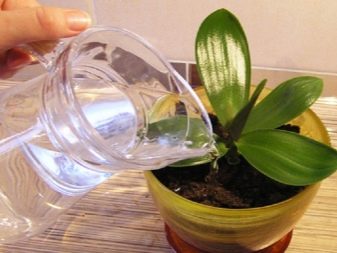
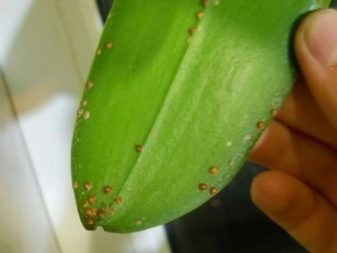
If the orchid has been infected with a spider mite, a small amount of moisture can be seen on the surface of the leaf blades, which eventually turns into a sticky liquid.
In addition, today there are a huge number of different drugs that will help fight sticky spots.
- Alirin-B. Often, instead of watering, damaged orchids are soaked in a container with water and dissolved tablets of this drug (2 pieces).
- "Phosphamide"... This drug is diluted in water and sprayed with it on orchids only if there are few parasites on the plants.
- Mospilan. This agent is an insecticide. It should be applied several times at intervals of ten days for the best effect.
- Fitosporin. This drug is a universal remedy for the treatment of fungal infections in plants.
- "Pure color". This product is intended exclusively for indoor plants. Often it is used not only for the treatment of sticky plaque, but also for prevention.
- Bordeaux mixture... It is a substance consisting of copper sulphate and lime, which copes well with bacteria on flowers.
- "Quadris". This drug is based on the substance azoxystrobin, which has a strong healing effect. It can also be used for plant prophylaxis.
- Fundazol. It is a fungicide (a substance that inhibits the development of fungal infections). Most often it is used against powdery mildew. The affected orchids should be treated several times at intervals of 3-5 days.
- "Zircon"... This drug is able to significantly increase the stress resistance of orchids. After its application, plants become less susceptible to the formation of rot, the appearance of powdery mildew and bacteriosis.
- "Trichodermin"... It is a biofungicide. It should be used as a prophylaxis or in case of damage to the root system and soil treatment.
- "Topaz"... Such a remedy is used precisely for fungal diseases. It is sold in small sachets in the form of an emulsion. For the best effect "Topaz" should be used together with contact fungicides.
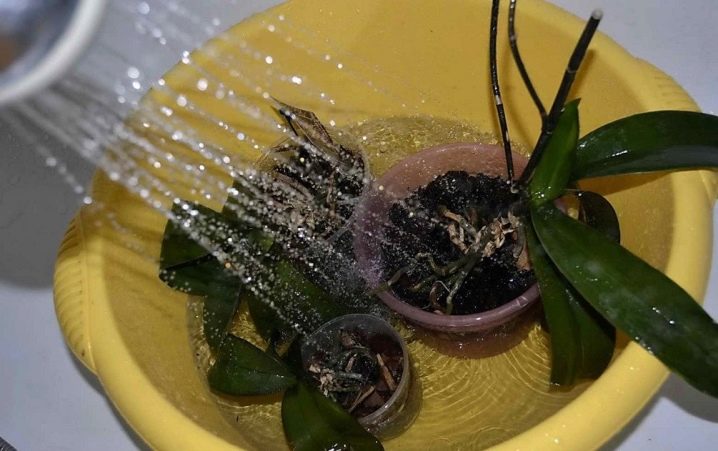
In addition, today there are a considerable number of folk methods to combat sticky plaque on orchids. So, you can treat flowers with ammonia, hydrogen peroxide. These substances are used to wipe the affected areas of plants with cotton wool. If the flowers are severely damaged, it is best to immediately use special chemicals. At the initial stages of infection, damaged parts can be treated with laundry soap, but after that it is imperative to use a chemical agent to completely eliminate the infection.
Sometimes cinnamon is used to treat these flowers. It is sprinkled with pre-treated infected areas of plants. If mold has formed in the pot, then you need to pour cinnamon all over the substrate. Moreover, this procedure must be repeated several times with an interval of several days.
We must not forget that in some cases the plaque formed may be harmless. After all, it can act as a defense against harmful insects, since such a sticky substance is a "trap" for them. Once in the liquid, insects will not be able to get out of it.
If over time, instead of small drops, whole sticky areas appear, this means that the pathological process of the disease has begun. In this case, rusty, black or yellow spots may later appear on the leaves and stems. Also, over time, leaf plates can completely change their natural color. They turn red or yellow in color, and are completely covered with bloom and liquid.


Prophylaxis
To prevent the appearance of sticky liquid on the orchid, it is recommended to periodically carry out a number of preventive measures. So, you should use special granules of special polymers, which can be found in almost any flower shop.
In addition, there are various vitamin cocktails for damaged flowers today. They can even be prepared at home. Most often they are made with succinic acid, zircon drops, glucose.
You also need to monitor the amount of water for orchids. After all, excessive watering can lead to the appearance of fungus, bacteria. We must not forget that such flowers require good lighting. Otherwise, powdery mildew may appear.
Orchids should also be checked regularly. When the first liquid drops are found, treatment should be started immediately. Also, the affected flower must be isolated from other healthy plants. As a prophylaxis, you can use the drugs "Actellik" and "Aktara". In appropriate dosages, they help to increase the immunity of such indoor flowers.
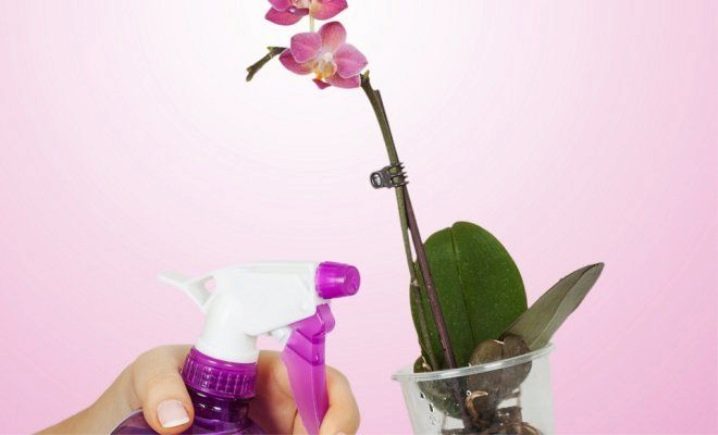































The comment was sent successfully.